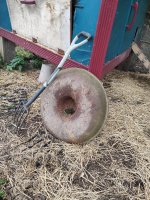I hope you get the chance to investigate so I can learn.Because for me the error is created somewhere in Ath, if you already have an ABEC project I can look at that to see if something looks wrong there.
^fluid made it work well in AKABAK with some smoothing and damping, but it seems there's little to improve within the script...
It can be done. See the posts around this one (including an example script): https://www.diyaudio.com/community/...-design-the-easy-way-ath4.338806/post-7055649
There's also a way to make a mouth rollback: https://www.diyaudio.com/community/...-design-the-easy-way-ath4.338806/post-7346246
There's also a way to make a mouth rollback: https://www.diyaudio.com/community/...-design-the-easy-way-ath4.338806/post-7346246
I'm working on a something like the ST260 but with an LF extension, according to the latest observations (and slightly larger). It's in the print now, I'm really curious...



After building a bunch of waveguides, you start seeing things and wondering, "would that work as a waveguide?"
Got dinner last night and noticed the cast ceramic sink looked like a good candidate lol


There are a lot of these beautiful cast iron pig feeders in the UK. They are very heavy and about 90cm diameter. It's tempting to make a throat insert!
Looks like a "spherical wave horn" to me. It's really hard to come up with something new these days... 🙂
This is a curious driver - the Selenium D2500Ti-Nd. It would need some DSP for sure but otherwise it's remarkably flat for a near-CD design.

(These are all raw responses for a constant voltage, measured without any filtering or additional processing.)
(These are all raw responses for a constant voltage, measured without any filtering or additional processing.)
Interesting - a small piece of an open-cell foam plug (roughly 1" thick) inserted into the horn at the end of the extension, where the "regular" WG starts. Typically, we would see an increasing attenuation with frequency but here it's almost constant across the whole band (blue = foam plug).

And with a larger volume of the foam:

And with a larger volume of the foam:
Last edited:
Wow. This seems really good to me. I am planning a two way project with satori wo24tx and a horn (compression driver not decided yet but maybe faital hf108) crossed between 1.1khz and 1.3khz. It could be a excellent candidate.
Faital HF108

Evidently, these are best suited for a DSP crossover where the frequency response can be flattened easily. There's not much more to be wished for regarding directivity...
BTW, this one also sounds very clean and go loud indeed.
Evidently, these are best suited for a DSP crossover where the frequency response can be flattened easily. There's not much more to be wished for regarding directivity...
BTW, this one also sounds very clean and go loud indeed.
Last edited:
Really nice ! I will minidsp flex so it will not be a problem to flaten. I see no downside versus regular st260 (am I wrong ?) and it offers me the possibility to extend the xo range experimentally from maybe 900 to 1.3.
With a slope of around 18db per octave, it means that to get overall 24 dB per octave, you should use a first order electrical only if I understand that correctly. So I'm wondering what distorsion figure you will get with Fc 800 Hz ?These extended devices are capable to be used considerably lower than that. It would be a waste of potential not ot make use of this, IMO. There should be absolutely no problem to go to ~800 Hz with this smaller waveguide.
Would you like to show CSD or waterfall plots?These extended devices are capable to be used considerably lower than that. It would be a waste of potential not ot make use of this, IMO. There should be absolutely no problem to go to ~800 Hz with this smaller waveguide.
Many compression drivers have resonances at their low end and this might result in increased distortion.
I've spent some time with all of this with the bigger (hexagonal) version - it's all here a few pages back. There the natural limit was around 600 Hz, here it will be a bit higher...
- I still had the HF108 on the jig - here's its distortion for 0,5 and 1 V.


Nothing to worry about, in my book.
SPL of harmonics for 0,5V (not calibrated!):

That's all I had time for at the moment...
This would need to be compared with (e.g.) the regular ST260 to better see the effect.
- I still had the HF108 on the jig - here's its distortion for 0,5 and 1 V.
Nothing to worry about, in my book.
SPL of harmonics for 0,5V (not calibrated!):
That's all I had time for at the moment...
This would need to be compared with (e.g.) the regular ST260 to better see the effect.
Last edited:
They all do - all transducers do, no matter if they are compression drivers or not. What's limiting is simply the increasing excursion with decreasing frequency. Below some frequency it will always rise steeply for a constant SPL - that's where it's better to stop pushing the driver.Many compression drivers have resonances at their low end and this might result in increased distortion.
Last edited:
- Home
- Loudspeakers
- Multi-Way
- Acoustic Horn Design – The Easy Way (Ath4)